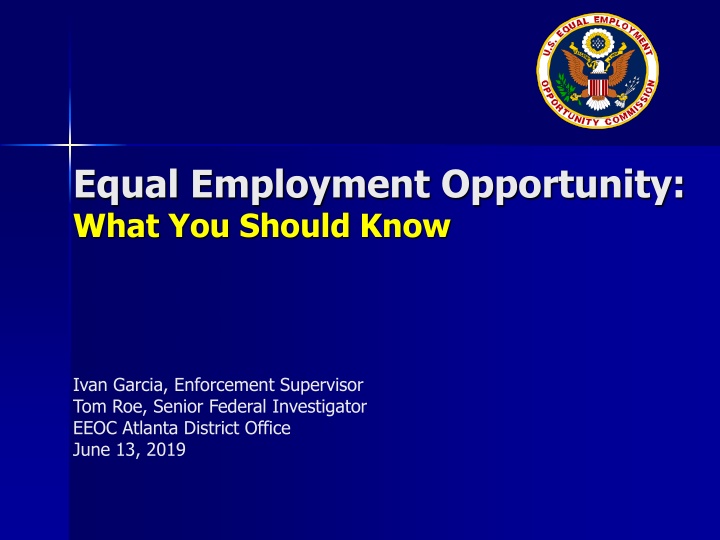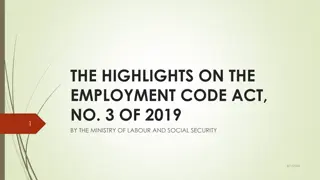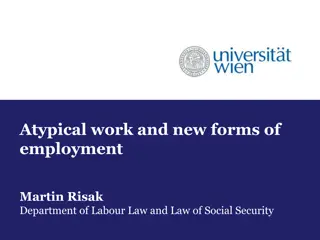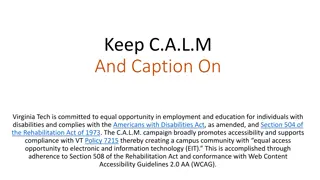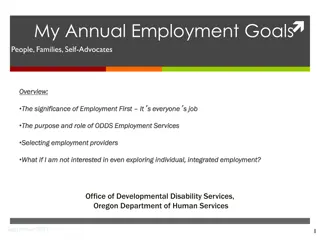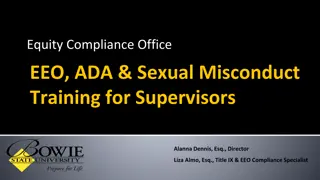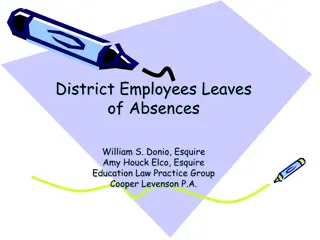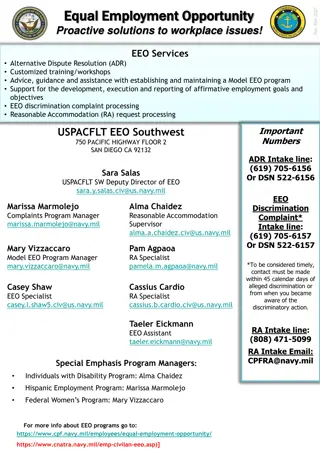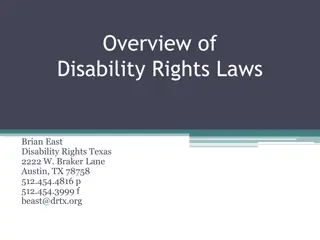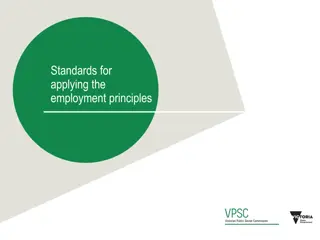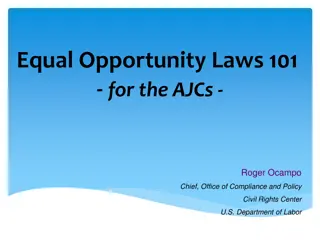Equal Employment Opportunity Overview: Laws, Protected Bases, and Covered Employers
Equal Employment Opportunity (EEO) laws protect against discrimination based on protected categories such as race, gender, age, and more. Employers covered by these laws must adhere to regulations related to hiring, promotions, benefits, and other aspects of employment. Understanding the basics of EEO is crucial for fostering a fair and inclusive workplace environment.
Uploaded on Mar 05, 2025 | 1 Views
Download Presentation

Please find below an Image/Link to download the presentation.
The content on the website is provided AS IS for your information and personal use only. It may not be sold, licensed, or shared on other websites without obtaining consent from the author.If you encounter any issues during the download, it is possible that the publisher has removed the file from their server.
You are allowed to download the files provided on this website for personal or commercial use, subject to the condition that they are used lawfully. All files are the property of their respective owners.
The content on the website is provided AS IS for your information and personal use only. It may not be sold, licensed, or shared on other websites without obtaining consent from the author.
E N D
Presentation Transcript
Equal Employment Opportunity: What You Should Know Ivan Garcia, Enforcement Supervisor Tom Roe, Senior Federal Investigator EEOC Atlanta District Office June 13, 2019
Equal Employment Opportunity is the law! The EEOC enforces federal EEO laws. Receive and resolve complaints of employment discrimination through: Mediation Conciliation Investigation Litigation EEOC s Mission To prevent and remedy unlawful employment discrimination and advance equal opportunity for all in the workplace.
Protected Bases It is unlawful to discriminate in employment because of: genetic info. color disability race national origin sex religion retaliation age (40+)
Prohibited Bases Federal EEO Laws Race Color Sex(includes pregnancy, sexual harassment, sex- stereotyping, sexual orientation, gender identity) Religion National Origin Sex-Based Wage Discrimination Title VII of the Civil Rights Act Apply to employers with 15 or more employees. Equal Pay Act Lilly Ledbetter Fair Pay Act Age (age 40 and older) Age Discrimination in Employment Act Apply to employers with 20 or more employees. Disability (physical or mental) Americans with Disabilities Act (ADA) Apply to employers with 15 or more employees. Genetic Information Genetic Information Non- Discrimination Act Apply to employers with 15 or more employees. Retaliation Apply to all of the above. Employer must have 15 or more employees.
Covered Employers Protected Individuals -- Private Employers -- Government Agencies -- Labor Organizations -- Employment Agencies/ Staffing Companies -- Joint Labor-Management Committees controlling apprenticeship and training -- Employees -- Job applicants -- Temporary workers -- Seasonal workers -- Part-time workers -- Former employees -- Undocumented workers -- Teenagers -- Paid Interns
Areas of Employment Covered by the Laws Include: Hiring Firing Recruitment Job Advertisements Compensation- salary, overtime pay, bonuses, vacation & holiday pay, gas allowances, travel reimbursement, stock options, retirement contributions, insurance Assignments Promotions Training Benefits Layoffs/Recalls Discipline Terms & Conditions
Proving Discrimination Individual is a member of a protected group (race, color, sex, national origin, religion, age, disability, genetic information, or retaliation) Adverse employment action. Harm occurred. Direct evidence (i.e., blatant racial statements, sex-based comments, or ageist remarks, etc.) Inference of discrimination similarly situated person(s) or comparator may suffice
Remedies Examples include: Monetary relief (compensatory/punitive) Reinstatement Promotion EEO training for the employer Change in employer policies/practices Attorney fees
EEOC Cases Aaron s to Pay $425k to Settle EEOC Race Harassment Suit (managers at a New York warehouse mistreated black employees by frequently using derogatory slurs and referring to them as monkeys ) Scribe-X Northwest to Pay $80k to Settle EEOC Pregnancy Discrimination Lawsuit (job offer for a young lady was rescinded when she notified Scribe-X that she was expecting) Lakeshore Sport and Fitness to Pay $45k to Settle EEOC Harassment and Retaliation Lawsuit (employee filed a discrimination charge alleging she had been harassed by another employee, and that her complaints were ignored. The club fired her for making the complaints) Kansas School District to Pay $11,250 to Settle Equal Pay Act Lawsuit (Female hired to be a Principal was paid $5,000 less than her male predecessor) Danny s of Jackson, LLC to Pay Over $3.3 Million in EEOC Race Discrimination Case (Limited number of shifts five black dancers could work, and subjected them to racially offensive epithets) Pape Material Handling to Pay $650k to Settle EEOC National Origin Harassment Lawsuit (Allowed employees to engage in ongoing harassment of Hispanic employees, including mocking employees accents and using derogatory slurs) Atlas Energy Group to Pay $85k to Settle Age Discrimination Suit (A 52-year old foreman with over 20 years of industry experience was pushed out of his job because of his age by a new, young superintendent) Saint Thomas Health to Pay $75k to Settle EEOC Religious Discrimination Suit (Because of religious beliefs, an employee was allowed to wear a mask 2013-2014, instead of taking the shot, but in 2015, he was fired instead of being afforded the accommodation)
The Cost of Discrimination Financial costs Legal representation Settlements Litigation Business costs Decreased productivity Increased turnover Reputational costs Customers/clients Applicants and employees 10
FY 2018 Highlights Charges Filed Charges Resolved Monetary Relief $505 Million 76,418 90,558
FY 2018 National Charge Stats BASES No. of Charges Received % of All Charges Received FY 2018 CHARGE NUMBERS BY BASES National Stats 24,655 Disability 24,605 24,600 Retaliation 39,469 51.6% 32.3% 32.2% 32.2% Sex Race Age National Origin 16,911 7,106 3,166 2,859 1,066 220 22.1% 9.3% 4.1% 3.7% 1.4% .3% Color Religion Equal Pay Act Genetic These percentages add up to more than 100 because some charges allege multiple bases. Information (These percentages add up to more than 100 because some charges allege multiple bases.)
Retaliation Prohibited It is unlawful to penalize or punish an employee or job applicant for asserting his/her EEO rights or engaging in protected activity, including: Filing or being a witness in a charge or lawsuit alleging employment discrimination, including harassment; Opposing employment discrimination; Resisting sexual advances or reporting an instance of harassment; Taking part in an internal or external investigation of employment discrimination; or Requesting an accommodation for religious purposes or because of a disability. Sometimes there is retaliation before any protected activity occurs. For example, an employment policy that discourages the exercise of EEO rights could itself be unlawful.
Examples of Retaliation Include: Termination Demotion Denial of Promotion Harassment Increased scrutiny Unjustified negative evaluations Unjustified negative references Transfer to an undesirable location
DISABILITY DISCRIMINATION
Title I of the Americans with Disabilities Act (ADA) Prohibits employment discrimination against qualified individuals with disabilities. Qualified individuals with a disability who are able to performed the essential functions of the job, with or without an accommodation. A disability is A physical or mental impairment that substantially limits one or more major life activities; A record of such an impairment; Being regarded as having a disability.
Examples of Impairments (Disabilities) Asthma Autism Arthritis Cancer Diabetes Epilepsy Migraines PTSD Bipolar Disorder Deafness Blindness Mobility Impairment (Wheelchair) Hearing Impairment Missing Limbs Multiple Sclerosis Cerebral Palsy Hypertension
The ADA Requires an employer to provide a reasonable accommodation to an employee or job applicant with a disability, unless doing so would cause significant difficulty or expense (undue hardship) for the employer.
Undue Hardship Defined as significant difficulty or expense in light of the employer s size, financial resources, and the nature and structure of operations. Consider the following factors: Nature and cost of the accommodation Financial resources of the employer Impact of the accommodation on the employer s operations and facility
Reasonable Accommodation Change in the workplace or in the way things are customarily done to accommodate a person with a disability. Accommodations to: Enable an employee to perform essential functions of a job Enable an employee to enjoy the benefits and privileges of employment Apply for a job
Types of Accommodations Job restructuring Modified work schedules Telework Leave Changing supervisory methods Obtaining or modifying equipment or devices Modifying the job application procedures Provide readers/interpreters
Leave as a Reasonable Accommodation EEOC Resource Document entitled Employer-Provided Leave and the Americans with Disabilities Act. www.eeoc.gov
ADA: Exclusionary Policies 100% healed policies Maximum medical leave policies Time and attendance policies These policies violate the ADA because the employer does not engage in the individualized assessment of an employee s ability to perform his/her job with a reasonable accommodation.
EEOC Cases Hyatt to Provide $100k in Pay and Benefits to Settle EEOC Disability Discrimination Suit (Company refused to allow front desk clerk to use a chair, as prolonged standing aggravated his back and caused pain) Time Warner Cable and Charter Communications to Pay $99.5k to Settle EEOC Disability Lawsuit (Company refused to allow employee accommodation in the form of leave to recover from surgery to remove cancer. Employee was fired while recovering from life-saving surgery) Arizona Health Companies to Pay $545k to Settle EEOC Disability and Pregnancy Discrimination Suit (Inflexible leave policies resulted in discharge of disabled employees vs. providing an accommodation which would allow them to continue working) Pilgrim s Pride to Pay $50,000 to Settle Disability Discrimination Lawsuit (employee requested and was granted leave to cover absences related to heart surgery. However, when he tried to return to work, the company claimed he was not granted leave and fired him for attendance) Corizon Health/Corizon LLC to Pay $950k to Settle Nationwide Disability Discrimination Suit (Company had an inflexible 30-day medical leave policy, and fired employees who needed more time. Accommodations could have allowed some employees to continue working (modified work schedules, reassignment, unpaid leave) Party City to Pay $155k to Settle Disability Suit (failed to hire a qualified employee after it became aware she required a job coach as a reasonable accommodation for her disability)
WORKPLACE HARASSMENT
Workplace Harassment Unwelcome verbal or physical conduct, based on Race or Color Sex Religion National Origin (Ethnicity) Age Disability Harassment at Work + Protected Basis = Workplace Harassment
What is Sexual Harassment? Unwelcome verbal or physical conduct of a sexual nature A form of sex-based discrimination, under Title VII of the Civil Rights Act Alters conditions of employment
Examples of Sexual Harassment Inappropriate touching, groping, cornering, rubbing, grabbing, pinching, etc. Sexual advances or pressures for dates. Comments, jokes, stories or innuendos of a sexual nature. Shoulder and neck rubs. Requests for sexual favors. Comments about a person s clothing, anatomy, or looks. Personal questions about someone s sex life. Sexually suggestive sounds or gestures (i.e., sucking noises, winking, pelvic thrusts). Ogling, leering or staring at a person s anatomy. E-mails, texts, pictures, letters, calls, gestures or materials of a sexual nature.
EEOC Cases IHOP to Pay $700,000 to Settle Sexual Harassment and Retaliation Lawsuit Atlanta Capes Fisheries & BJ s Service Co. to Pay $675,000 to Settle EEOC Sex Harassment and Retaliation Suit Missouri to Pay $600,000 to Settle Sexual Harassment Lawsuit Filed by Corrections Employee Favorite Farms to Pay $85,000 for Sexual Harassment and Retaliation Dunkin Donuts Franchise to Pay $150,000 for Sexual Harassment Suit Sirdah Enterprises/Taboo 2 Consents to $250,000 Judgment to Settle Sexual Harassment Suit Meat Packing Co. Settles Sexual Harassment Suit for $100,000 Subjected Female Employees to Unwanted Touching and Comments EEOC Sues Alliance Ground International For Sexual Harassment and Retaliation EEOC Sues Anchor Staffing For Sexual Harassment and Retaliation After Employee Complained About Sex Harassment, Staffing Company Ended Her Assignment and Denied Her Future Assignments Security Company to Pay $155,000 to Settle Same-Sex Sexual Harassment / Retaliation Suit
Harassment Types of Harassment Hostile Work Environment - Creates an intimidating, hostile, or offensive work environment Can be committed by a manager/supervisor, co-worker, or non-employee. Does not result in a tangible employment action. Interferes with employee s work. Employer is liable if: Knew or should have known about the harassment; and Failed to take immediate and appropriate corrective action. Tangible Employment Action - Tangible job benefits are granted/denied based on submission/rejection of unwelcome conduct. Results in significant change in employment status or benefits. Examples include: hiring, firing, demoting, reassignment, reducing pay, denying promotion, assigning work, retaliating Committed by a supervisor or manager. Automatic liability Standards: severe, pervasive, reasonable person
Preventing Harassment Five Core Principles Committed and engaged leadership. Consistent and demonstrated accountability. Strong and comprehensive harassment policies. Trusted and accessible complaint procedures. Regular interactive training tailored to the audience and organization. www.eeoc.gov/task_force/ harassment/report.cfm
Eliminating Discrimination and Harassment in the Workplace is Everyone s Responsibility
Employers Responsibilities INCLUDE: Ensure that employment decisions are not based on race, color, sex, religion, national origin, age, disability, genetic information, or in retaliation. Ensure that work policies and practices are related to the job and do not disproportionately exclude people of a particular race, color, sex, religion, national origin, disability, or age. Ensure that employees are not harassed because of protected bases. Respond promptly and adequately to complaints of discrimination or harassment. Guard against retaliation. Provide reasonable accommodations for a disability or religious purposes. Display a poster and keep employment records, as required. **Preventing discrimination is good business.**
Managements Responsibilities Don t discriminate. Comply with EEO laws. Set a good example for employees to model. Take allegations of discrimination seriously and respond appropriately. Stop harassment immediately. Seriously consider requests for accommodations. Know and consistently apply company s policies. Don t retaliate. Consult HR as needed. Use social media responsibly.
Employees Rights & Responsibilities RIGHTS Work free of discrimination and harassment Complain about job discrimination without retaliation Keep medical information private RESPONSIBILITIES Don t discriminate or harass Report Discrimination Request reasonable accommodation (religion or disability) Obtain a copy of Employee Handbook Become familiar with company s policies
START WITH YOU What Can You Do? Respect others Recognize your own biases and prejudices, and don t act on them Don t treat people differently because of race, color, gender, national origin, religion, age or disability. Think before you speak Be careful with humor Use social media responsibly If in DOUBT, don t do it; don t say it Ask yourself, if I were being recorded would I do or say these things?
PROMISING PRACTICES FOR EMPLOYERS Implement a strong EEO policy that is embraced at the top levels of the organization and communicated to all employees. Keep current on employment laws and update policies accordingly. Train managers and supervisors on EEO laws and company s policies. Don t tolerate discrimination/harassment. Promote an inclusive culture by fostering an environment of professionalism and respect. Foster open communication and early dispute resolution.
PROMISING PRACTICES FOR EMPLOYERS Ensure that all employment decisions are based on job related criteria Establish neutral and objective criteria to avoid inconsistent and subjective employment decisions based on personal stereotypes, assumptions, or hidden biases. Review leave policies for compliance with ADA & Title VII. Avoid exclusionary policies: 100%-healed policies Maximum medical leave Time and attendance policies Review background check policies and practices for compliance with Title VII.
PROMISING PRACTICES FOR EMPLOYERS Recruit, hire, and promote with EEO principles in mind, by implementing practices designed to widen & diversify the pool of candidates considered for employment. Monitor for EEO compliance by conducting self- analyses to determine whether current employment practices disadvantage particular groups of people or treat them differently. Review compensation structure and practices. Guard against retaliation. Keep your policies current, your practices consistent, and document, document, document!
EEOC Resources www.eeoc.gov Annual Seminar Aug 23 & 24 in Atlanta Small Business Resource Center Publications and Guidance Materials On-site Training for Employers Free Outreach Mediation Program Contact EEOC 1-800-669-4000 1-800-669-6820 (TTY)
2019 Annual EXCEL Training Conference July 30 August 1, 2019 Atlanta, Georgia www.eeotraining.eeoc.gov
THANK YOU! Ivan Garcia Tom Roe EEOC Atlanta District Office 100 Alabama St. SW, Ste. 4R30 Atlanta, GA 30303 (404) 562-6859 l 1-800-669-4000 thomas.roe@eeoc.gov www.eeoc.gov l www.eeotraining.eeoc.gov
